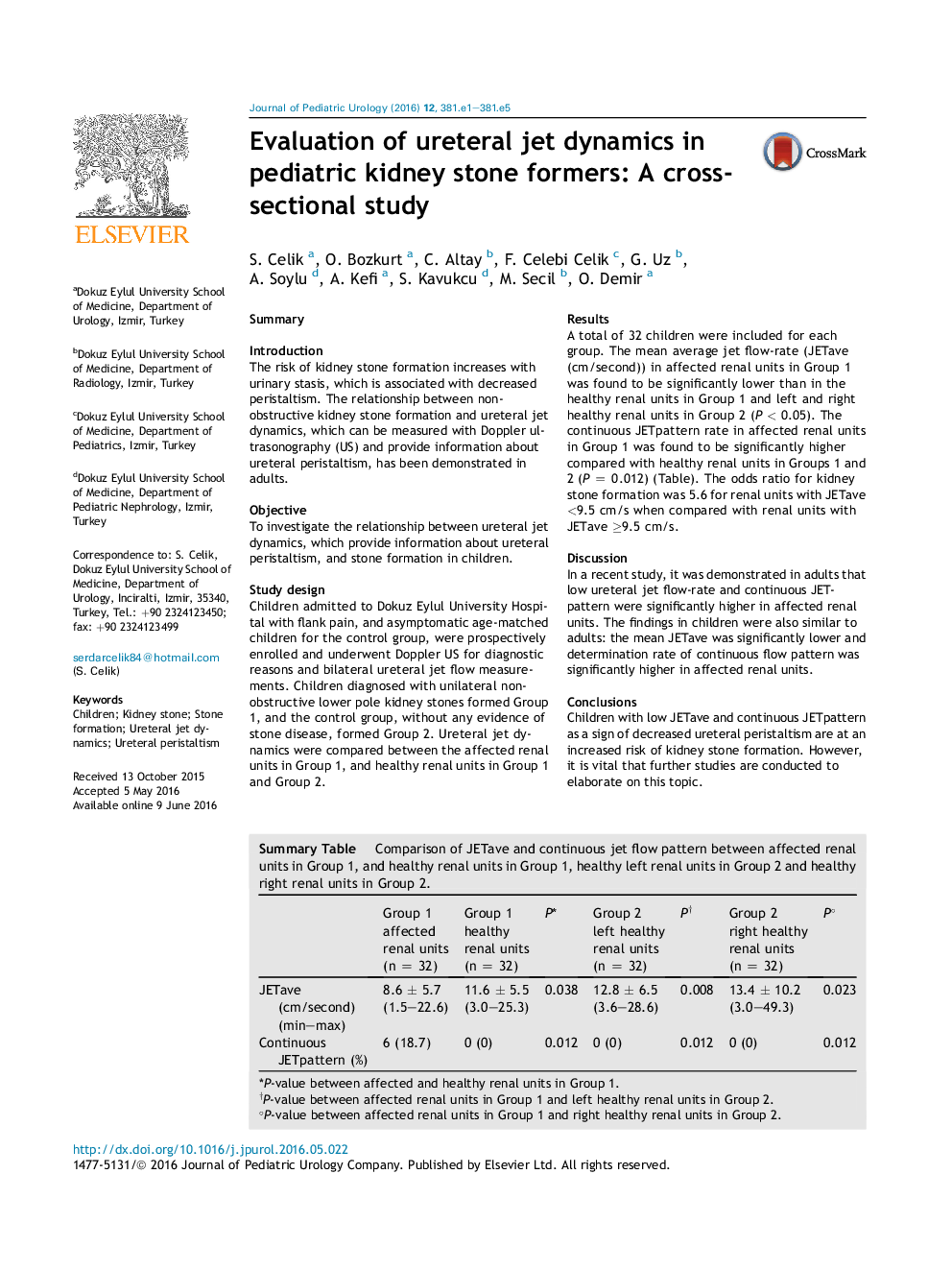| Article ID | Journal | Published Year | Pages | File Type |
|---|---|---|---|---|
| 5718706 | Journal of Pediatric Urology | 2016 | 5 Pages |
SummaryIntroductionThe risk of kidney stone formation increases with urinary stasis, which is associated with decreased peristaltism. The relationship between nonobstructive kidney stone formation and ureteral jet dynamics, which can be measured with Doppler ultrasonography (US) and provide information about ureteral peristaltism, has been demonstrated in adults.ObjectiveTo investigate the relationship between ureteral jet dynamics, which provide information about ureteral peristaltism, and stone formation in children.Study designChildren admitted to Dokuz Eylul University Hospital with flank pain, and asymptomatic age-matched children for the control group, were prospectively enrolled and underwent Doppler US for diagnostic reasons and bilateral ureteral jet flow measurements. Children diagnosed with unilateral nonobstructive lower pole kidney stones formed Group 1, and the control group, without any evidence of stone disease, formed Group 2. Ureteral jet dynamics were compared between the affected renal units in Group 1, and healthy renal units in Group 1 and Group 2.ResultsA total of 32 children were included for each group. The mean average jet flow-rate (JETave (cm/second)) in affected renal units in Group 1 was found to be significantly lower than in the healthy renal units in Group 1 and left and right healthy renal units in Group 2 (P < 0.05). The continuous JETpattern rate in affected renal units in Group 1 was found to be significantly higher compared with healthy renal units in Groups 1 and 2 (P = 0.012) (Table). The odds ratio for kidney stone formation was 5.6 for renal units with JETave <9.5 cm/s when compared with renal units with JETave â¥9.5 cm/s.DiscussionIn a recent study, it was demonstrated in adults that low ureteral jet flow-rate and continuous JETpattern were significantly higher in affected renal units. The findings in children were also similar to adults: the mean JETave was significantly lower and determination rate of continuous flow pattern was significantly higher in affected renal units.ConclusionsChildren with low JETave and continuous JETpattern as a sign of decreased ureteral peristaltism are at an increased risk of kidney stone formation. However, it is vital that further studies are conducted to elaborate on this topic.Summary Table. Comparison of JETave and continuous jet flow pattern between affected renal units in Group 1, and healthy renal units in Group 1, healthy left renal units in Group 2 and healthy right renal units in Group 2.Group 1 affected renal units (n = 32)Group 1 healthy renal units (n = 32)P*Group 2 left healthy renal units (n = 32)Pâ Group 2 right healthy renal units (n = 32)P°JETave (cm/second) (min-max)8.6 ± 5.7 (1.5-22.6)11.6 ± 5.5 (3.0-25.3)0.03812.8 ± 6.5 (3.6-28.6)0.00813.4 ± 10.2 (3.0-49.3)0.023Continuous JETpattern (%)6 (18.7)0 (0)0.0120 (0)0.0120 (0)0.012*P-value between affected and healthy renal units in Group 1.â P-value between affected renal units in Group 1 and left healthy renal units in Group 2.°P-value between affected renal units in Group 1 and right healthy renal units in Group 2.
